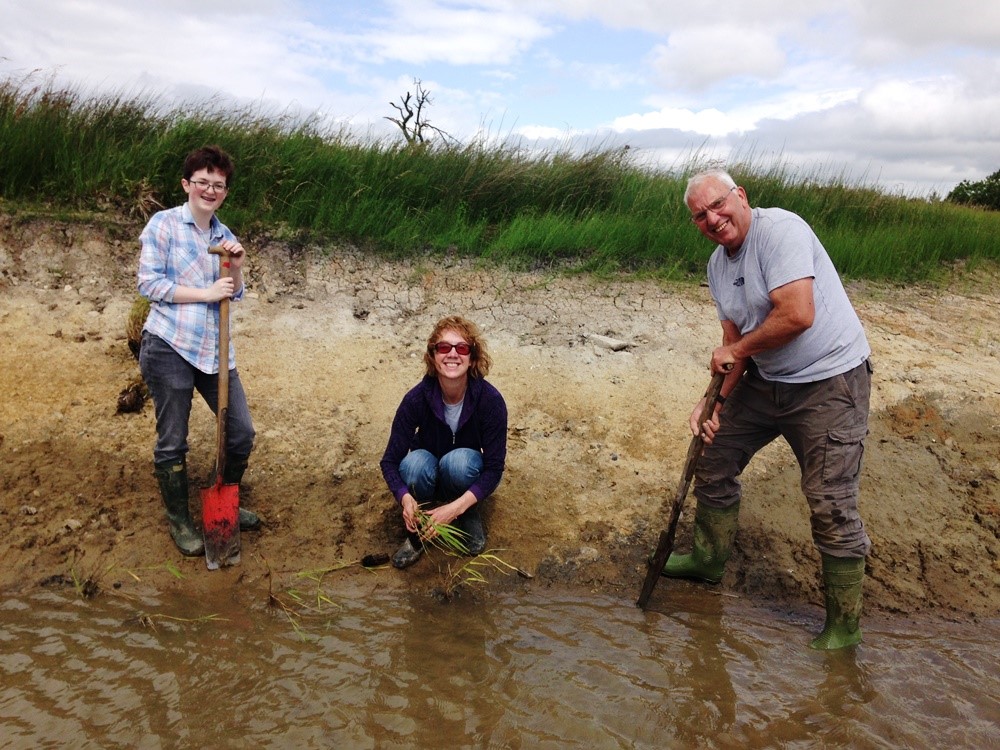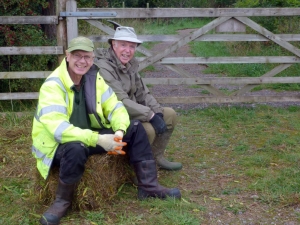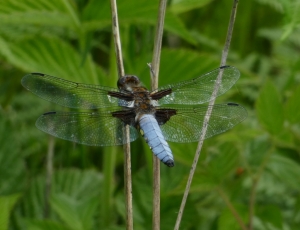Blog Archive (32) Posts Made in May 2017
A drone but not of the bee variety…
Wednesday, May 31st 2017
As with every Wednesday morning there is always the joy of opening the moth trap put out the previous evening. It had been a fairly chilly evening but did have 12 species and 26 moths. This included three impressive Poplar Hawk moths, plus beauties such as this Common Swift,
….an unusual looking Pale Prominent…
….and this Map-winged Swift.
The sun shone on the reserve all day, which was ideal because we ran a pond dipping event for families as it's school half term!
Various pond critters were discovered including this female Palmate Newt…
….and this cluster of Caddis Fly larvae; look closely and you can see some legs and heads! These are probably of the genus, Limnephilus. They stick plant matter to a membrane and use it much like a snail uses a shell. We quite often get the odd flighted adult in the moth trap. There are actually three Caddis fly larvae in this cluster.
There was also a lot of excitement with the diving beetle larvae attacking a tadpole and then feeding on it using its large pincer like mouth parts to suck it dry!
With the pond dipping finished we returned to the Field Centre to make egg box frogs - the results speak for themselves:
Ben Wilkinson attended the site for a recce flight with his small drone with the intention to take aerial pictures of the reserve as part of the 25 year celebrations taking place this year.
Thank you to the moth team, the flower walk team and John (out recording butterflies) for recording our species today.
Getting Loads Done
Tuesday, May 30th 2017
Another Tuesday and another day where we get loads done with the help of our wonderful volunteer team – thank you all! We continued preserving and painting marker posts,

cleaned out the tadpole tank, maintained loppers, repaired grip on boardwalk, tided the workshop (these things always seem to look worse mid-job than either before or after!),

made repairs to the access track and strimmed, mowed and trimmed back vegetation overhanging some of the paths (the warm weather and recent rain has really made everything grow!). We weeded paths,

filled bird feeders (here John and John are just getting seed out ready),

trimmed the Field Centre hedge

and cleared moss from the downpipes and drains, washed from the roof by the rain…

….a find here included this rather handsome ground beetle.
.jpg)
Two of our mink rafts were repaired – including a little fishing for a lost component…

The repair process also turned up one of the exciting sightings of the day: A dipper fishing down at Risedale Beck – lovely!
.jpg)
It Has To Be Water Droplets!
Monday, May 29th 2017
After weeks of dry weather there were thunder storms and accompanying rain on Saturday and today it was rain and mist and damp. Good for the plants but even better for photographing water droplets!
Water Avens are setting seed and they are ideal to catch the rain.

The Bluebells on the moor have gone over now but their place has been taken by Pignut. White flower heads had caught the water so that they were heavily laden.

Bird'sfoot Trefoil flowers were also decorated.

Bird's Eye Primrose or Mealy Primrose is flowering on the moor. Some flower heads had caught more rain than others.

It was not only plants that received their fair share of raindrops, beetles did too. This was probably not the best place to shelter.

This was where the blog was going to end today but sitting having a tea break I noticed a Jay on the side of the peanut feeder. A visitor said that it had managed to move the metal that closes the hole after the peanuts have been added. It manged no problem. The photos taken are not very good, through the window and in the drizzly conditions but it does show what these intelligent birds can do!

Getting peanuts the easy way!

Before leaving I removed the peanut feeder, just in case a small bird managed to find the hole and get trapped overnight. Colin, who keeps an eye on all our feeders, and comes up with ideas to stop damage by bigger birds and squirrels may have his work cut out on this one.
The Birds and the Bees
Sunday, May 28th 2017
Today was the last of two days on the Introduction to Beekeeping course held at the reserve by the Richmond and District Beekeepers. Again it was a day of lectures; this time on equipment and then on more detailed subjects such as swarming.
With no thunder storms in sight, we ventured onto the heath where we were able to get close and personal with the temporary hives there.
There was plenty of chance to put theory into practice and use the basic knowledge we had gained under the watchful eyes of the beekeepers instructing us.
The large bee cell sticking over the frame is a capped Queen cell, indicating the bees may swarm.
With the practical finished we ensured all bees were carefully removed from our suits before heading back to the Field Centre.
Thank you to all that attended the course and especially the folk who arranged it.
We had a busy day at the reserve, the bird ringers had been there since 4.15am. Although a fairly quiet day we were able to do some nest boxes and one highlight was a Kingfisher. This was a male, which has a fully black lower mandible, or beak. The female has a pale lower beak!
You can tell by the feet of the Kingfisher that it was a adult by the lack of black, or dark brown on the upperpart. This was a newly ringed bird, which we hope to see again in the coming years.
Thank you to the commitment and dedication that all our early morning ringers do for both the reserve, and by collecting data for the British Trust for Ornithology.
Interesting Bits and Pieces
Sunday, May 28th 2017
On Wednesday we caught a moth in the trap and we said 'We know that.' Unfortunately after searching the moth ID book to no avail we decided that we did not know the moth. A suggestion 'Is it a micro?' Out came the micro book and yes it was, a female Bee Moth.
Caterpillars eat green plants, well most do, but not this one. The larvae feed on old cells and debris of bee and wasp nests. They also feed on the brood itself. Masses of pupal cocoons made of dense, tough silk can be found in dry, dark places.
The very warm weather ensured that few moths sat still very long for a photo to be taken, so one in the pot first and that was the only one!

Most green plants photosynthesise. Some like Yellow Rattle, Lousewort and Eyebright are semi-parasitic living off other green plants. Common Butterwort is insectivorous and catches insects on its leaves, which then roll up and the insects are digested, in this way providing nutrients for the plant. Its beautiful flower, just opening, belies its feeding habits!

Some years ago I noticed that some of the Red Campion flowers along Risedale Beck were producing brown pollen from their stamens. It wasn't until a later date researching Red Campion that I found that it was not pollen but a fungus called a smut, Campion Anther Smut.
It has not been recorded for some time, but this year it has made its appearance on flowers at the head of the Scrapes. Those along Risedale Beck do not flower until later.

CES 3 took place today. Nest boxes, on the training area were also checked. Thank you to everyone who helped today.
Bees and Deluge
Saturday, May 27th 2017
At the reserve today we had the first day of the Richmond and District Beekeepers’ Association Introduction to Beekeeping. This is a weekend course to basically see if beekeeping is for the folk attending. We spent the morning in the activity room having a fact filled lecture by Keith Bartlem.
In the afternoon, looking like we were invaded by aliens, we donned our bee suits and had a hands-on experience with bee hives on the Heath. As you can see from the photo the clouds were darkening.
.JPG)
We abandoned the outdoor work for the shelter of the Field Centre, and not before time as the heavens opened. The track was a beck, and the gutters struggled to hold the torrential rain, 18 mm fell by the time I left the reserve.
Brian Slater, our weekend volunteer, managed to take some lovely photos, before the thunder and lightning, of this newly emerged 4-Spotted Chaser….
…a Pine Weevil was also spotted. Although interesting to see it can be a serious pest to pine and spruce , damaging young shoots and the root system.
This Green Veined Butterfly caterpillar had recently hatched out on a Cuckoo Flower.
Thank you to Brian for all his help today, and lets hope the weather is better for the beekeepers, and the bird ringing tomorrow.
A Story to Tell
Saturday, May 27th 2017
Out on the wetland checking for flowers and Adder's Tongue Fern, I noticed a toad, as Christine knelt to check a leaf. I was just about to pick up this toad when I realised that toads are not furry!

We watched and it kept its head tucked in the grass, obviously it couldn't be seen if its head was hidden. It then decided it would head off and ran across the path where it encountered my pup's tail. Initially the vole thought this would be a good place to rest and curl up, but then thought better of it and continued its journey across the path and into more vegetation.

After this interlude we continued on our way checking for flowers. Common Milkwort has spread on the wetland but we could find no more than one clump on the moorland.

Lousewort is also to be found on the wetland and moorland.
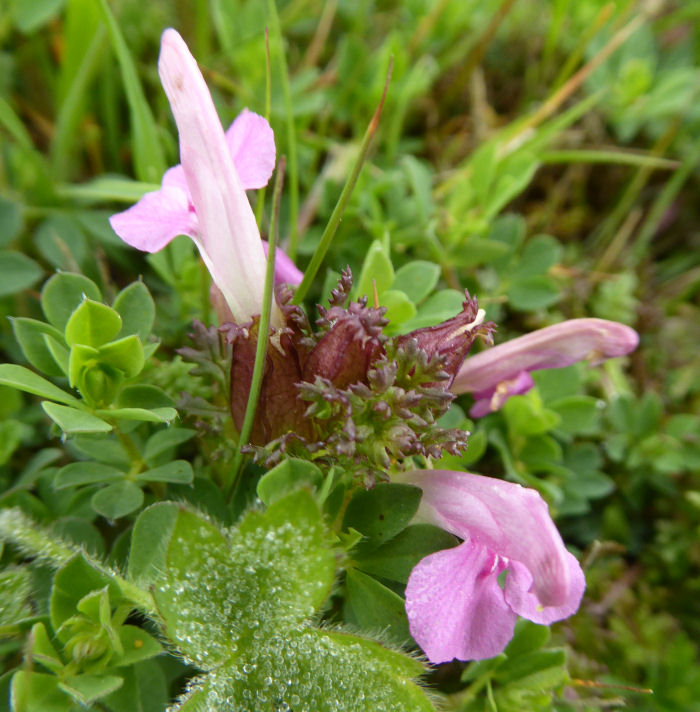
Dog Daisies are open along Dog Daisy Avenue - where else would they be?

In the back garden, Daisy, but this one tinged with pink.
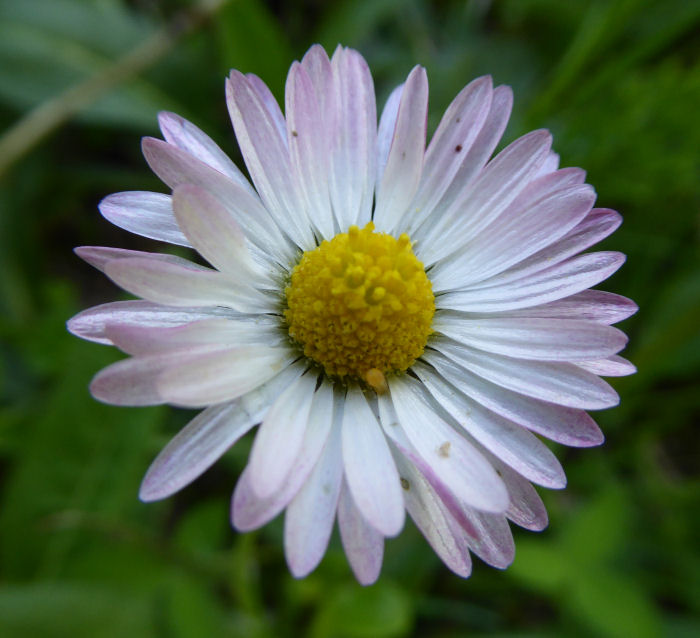
Large Boxes and Large Logs
Friday, May 26th 2017
Today was our final school visit of the week, where we hosted Hackforth and Hornby C of E Primary School for mini-beast hunting, pond dipping and a poetry walk. It was a fun (and very hot) day, with the whole of this small school visiting us. There were keen pupils (and teachers!) and we were impressed by the support older pupils were giving to the younger ones!
Next week we take a break from school visits for half term – instead running two activities for families (there’s still some space – you can book though our events pages here) and hosting walks as part of the Swaledale Festival..!
Our licensed bird ringers also completed another circuit of the large boxes at Foxglove, to ring jackdaw chicks with their beautiful blue eyes…

…and this stock dove, still sitting on her eggs.

Peter mowed, strimmed and filled bird feeders ready for bird ringing at the weekend (it’ll be this Sunday morning if you’d like to have a look). We also made some small adjustments to the positioning of our new large logs with the help of Willie Metcalfe.

Thank you to all who helped us today – it was another busy one!
A Hot Day!
Thursday, May 25th 2017
With temperatures reaching 27.5 °C in the shade it was not surprising that we were sweating when standing still. The team of volunteers donned various head wear to keep the sun from baking scalps. Christine looked particularly summery as she re-vamped the various route marker posts around the reserve.
We are gradually going around the reserve and giving a face lift to the various green, red and yellow route marker posts.
There is a fair amount of these posts which need taking out, stained, colours touched up then put back looking fresh. This is no easy task and it all takes time.
The rest of the team strimmed and mowed the net rides ready for the bird ringing on the weekend, as well as doing the important water and dam checks that ensure that we have water in the places that need it. Andrew put out the hose for the grass in front of the Field Centre as it is looking rather thirsty at present!
In the Field Centre Ivan was putting some edging which tidy ups some areas, and the results speak for themselves.
Thank you to all that helped today.
Waiting for quiet in the Scrapes…
Wednesday, May 24th 2017
Today was especially busy for us with school visits, as we had not one group, but two, joining us: Years 1 and 2 at Hipswell C of E Primary School. Year 2 were with us for the morning and year 1 in the afternoon! With only half a day each, we squeezed in two of our activities with each group to explore different habitats: Mini-beast hunting …


…and pond dipping.


The first group also put out apples on the water vole feeding platforms. They were delighted to find that one had already been started when they came back to check before they left at lunchtime. However the water voles stayed out of sight until it was a bit quieter in the Scrapes – then we spotted this one tucking into one of those tasty apples!

We are fully booked for school groups this summer, but you can book now for the autumn term, through our website on our education pages, or by phone or email.
Summer Jobs!
Tuesday, May 23rd 2017
With temperatures reaching the mid-twenties today the volunteers dressed in their summer gear and did the usual of getting on with the varied tasks of the day. The jobs took folk up onto the green route repairing boardwalks, to the network of paths we use on a regular basis behind the net rides near the pond dipping areas. The amount of of new growth hanging over these paths and impeding free travel produced a fair bit of brash; sun and rain really pushing on the growth of all vegetation….
.... including the Field Centre grass
The bird seed feeders and hoppers are a regular job twice a week
...and even the feed available to buy at the Field Centre was bagged up
There were plenty of bugs in the air, no doubt providing plenty of food scource for the various nesting bird chicks. This male Pale Tussock moth was found on the building this morning looking a bit like a lop-eared rabbit!
Rhagium bifasciatum, sometimes called the two-banded longhorn beetle, not the most elegent flyer, landed on me as I was walking to the wetland. This beetle of about 22mm lays its eggs in dead wood, often using coniferous trees. The grubs bore deep broad tunnels to pupate after about two years of feeding. They quite often form part of a woodpeckers diet.
In the afternoon the team were more than willing to start the filling of potholes that had developed over the past months.
This involves the use of the wac-a-plate to compact the gravel to prevent it being washed out by a rare rain shower!
Thank you to the hard working team that certainly give plenty of sweat, now and then a little blood and certainly no tears; thankfully plenty of smiles and banter!
Chicks, Creepy Crawlies, Ponds and Poems
Monday, May 22nd 2017
This morning started with some cute encounters: First a pheasant spotted wandering around near our workshop with her clutch of chicks…

…then a brief foray for some of our licensed bird ringers to give rings to a nest of tawny owlets and to this lovely nest of robins found by Leanne over the weekend.

While some of the bird ringers continued with nest box checks, our day continued with the arrival of a year 4 class from Leyburn CP School: a lively and enthusiastic bunch!

We explored our ponds…

…searched for mini-beasts…

…and wrote nature poems while taking a look at habitats.


Some great poems and a busy day for all!
New Life
Sunday, May 21st 2017
Jack, on Salisbury Plain, like our bird ringers at Foxglove, has been busy ringing chicks. He emailed his news.
'I hope you are well and no doubt you are busy. I'm struggling to keep up with nests at moment which is good, with about 80 or more nests found. Good numbers of Dunnock and Whitethroat, with 15 Whitethroat on eggs as of today. I have already ringed many Dunnock, some Blackcap and two broods of Chiffchaff. Couple of pics of Lotti (Long-tailed Tit) that had just fledged. I managed to catch 6 of around 8 or 9 but I'm not as nimble as a used to be!'


Foxglove bird ringers are busy and waiting for more information this evening as to their next visits to large and small boxes. There are still many boxes to check and return to.
Leanne found this nest of Robin chicks. We commented on the fact that it is not a brilliant nest, but the chicks look well fed and ready to fledge soon. Can you find it?
.jpg)

Spring is well on its way although the weather has not always been spring-like. Mayfly often hatch in great numbers and are food for many a bird feeding hungry young. This one was waiting for the temperature to rise before heading off back to water. Their lives are very short, a few days at the most. They have no mouth parts and so do not feed, once mated and eggs laid, they die.

A Green Veined White butterfly was also hanging on to grass waiting for some sun. It will lay eggs on a wide variety of plants, including Cuckooflower, Large Bitter-cress and Jack-by-the-hedge.

Large Red Damselflies, the first of the 'dragons and damsels' to appear, were recorded at the beginning of May, but the cooler weather reduced the sightings to nil. The photographers who love creepy crawly beasties, bemoan the cooler weather. When the sun comes out and it is warm, so do the inverts, which is really good news. But very often they are so active they do not sit still long enough to be photographed! This one was caught just before it warmed up!

Some people may say that I am very protective of the orchids that grow at Foxglove, which is very true. There is a map in the office known as the 'Orchid Map' which highlights all the areas where orchids can be found. Anyone armed with a strimmer has to check this map before heading off to strim. (Thank you for being so careful.) The Northern Marsh Orchids are the next to flower after the EPOs and they are in bud in their usual place, except one. Not only is it growing away from the usual areas it is in flower.

Birdsong Breakfast
Saturday, May 20th 2017
As the sun rose at Foxglove this morning, the reserve was already a hive of activity. The reason for this was the annual Birdsong Breakfast. This popular event sees people from far and wide, emerging bleary eyed from their beds during the hours of darkness to arrive at the field centre in time for dawn. The moon was still up, above the reedbeds, as forty two people joined us for a walk around the reserve.
Dividing into groups we headed out onto the reserve to investigate which birds we could hear singing. Everything was damp and laden with raindrops.
Over 30 different bird calls were identified. It is nice to be out on the reserve as the sun is coming up - the dawn light is always rather pretty.
The bluebells are at their best at the moment, and with the yellow gorse, make a lovely sight at dawn.
Afterwards, we all headed out onto the military ranges to see what we could find there. Black grouse were seen and curlew chicks were also found. This curlew, with its beak open appears to be mid call!
Finally we all headed off to Wathgill for a well-deserved fat boys' breakfast. With such mixed weather in recent days we wondered whether we would even be able to run the event at all, but the day dawned bright and relatively mild and everything went ahead as planned. We are grateful to those who came to lead the bird song walks.
A Privilege
Friday, May 19th 2017
We are fortunate to visit various locations on the Catterick training area to check nest boxes, collate the data and ring the various birds.



.jpeg)
.jpeg)
.jpeg)
These photos were taken earlier this week at just one of those beautiful sites by one of our licenced ringers Leanne Stollery, and a few of the less pretty ones by myself!
Diverse Days
Thursday, May 18th 2017
The past few days have really been a mixed bag; it goes to show how diverse our lives as Reserve Managers can be. Yesterday started off with the moth trap being opened with 15 species and just 30 moths, but it did contain the first hawk moth of the year, a Poplar Hawk Moth. Although it is a fairly common moth this time of year it always impresses.
There was also a Scalloped Hazel.
Hipswell Primary School attended ....
.... giving us a chance to show them the moths and other mini beasts,
….and the pond dipping coming up with leeches, Great Diving Beetles - the one below which is over 30mm, is identifiable by the ridges along her back which the male clings onto….
….and a Water Vole which could not wait for us to vacate the pond dipping platforms to scoff its apple.
It is rarely seen so close to such activities like pond dipping!
Today was dominated by CES. We are a Constant Effort Site for the BTO (British Trust of Ornithology), where we put in 16 mist nets for ten and a half hours in the same place, around the same time of year for twelve sessions. We have been doing this for the last 25 years, and due to the length of time and effort put in by our licenced ringers is an important scientific data set. One of the birds that came to the nets today was this Carrion Crow, not everyone’s favourite but an unusual bird to have in our nets!
Our Thursday volunteers are great at just getting on with tasks we give them, and we thank all that attended today for their fantastic efforts and quality of work.
Species Update
Wednesday, May 17th 2017
Whilst the reserve managers and volunteers were identifying moths, counting Early Purple Orchids, helping with a school visit, checking nest boxes and working out when to return to ring the chicks, it was inputting species data for me. The April monthly observations had to be entered. It is useful to be next to another computer!
.jpg)
Once these had been inputted it was time to check against the Foxglove 25 Challenge list, which is to see how many of the species on our list we can record during our 25th year. Figures now stand as follows, flowering plants at 79, birds at 47, whilst invertebrates have jumped from 2 to 23, excluding the moths.
From this I started to look for some species photographs, but got waylaid, as I found this one of our 'Highlanders' who grazed the moor.
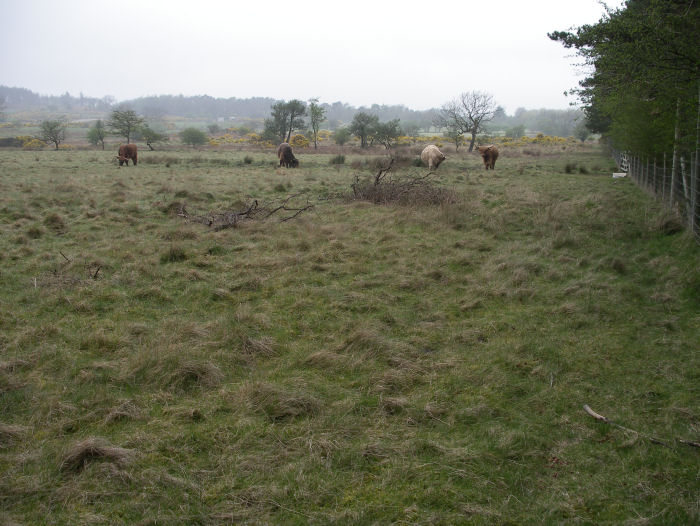
Followed by the middle moor, photographed last year. A bit of a change.
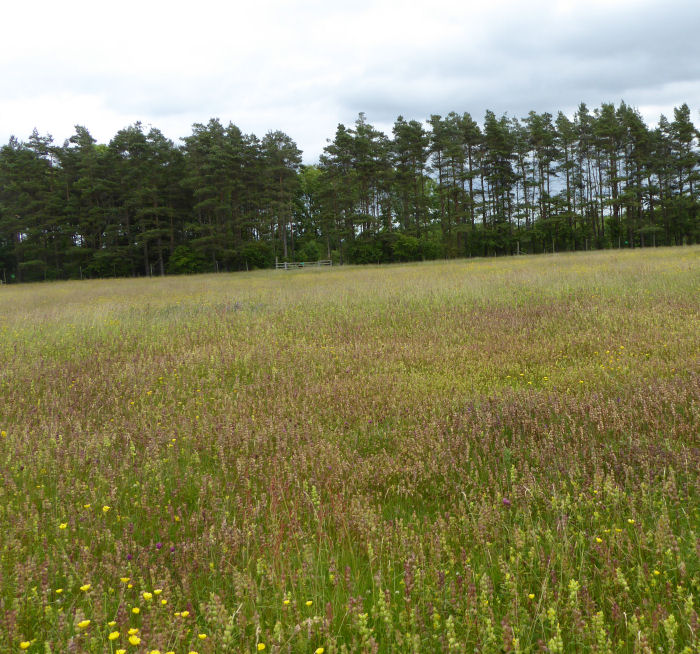
Then I went back to the species. White Clover will flower on the middle moor.
.jpg)
Bird's-foot-trefoil will also show its sometimes red and yellow flowers.
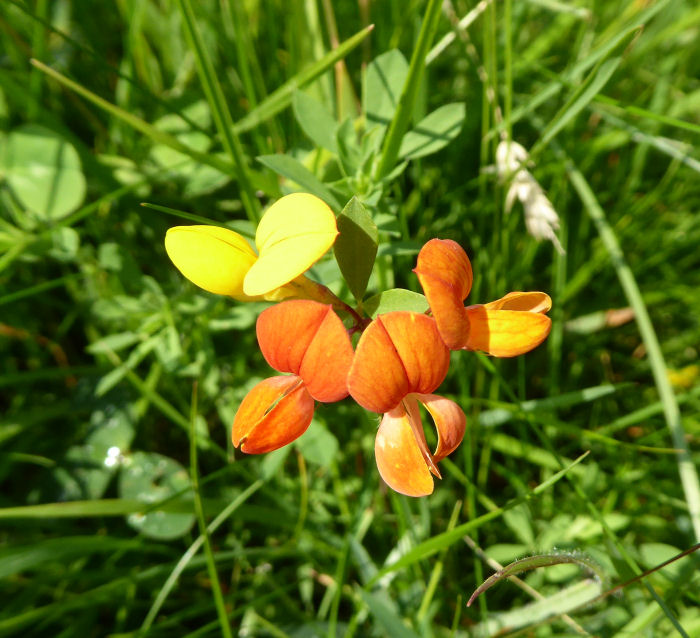
We have to wait a little while for these to appear but Wild Garlic is flowering.
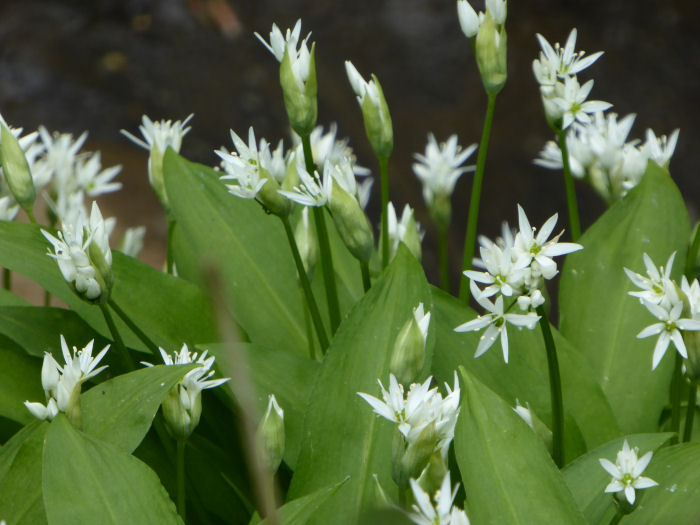
At the head of the Scrapes Wild Crab Apple is in flower.
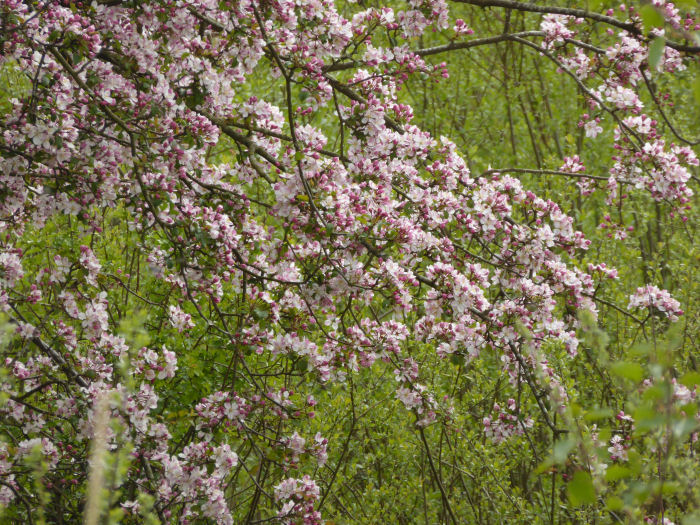
Volunteering covers many areas of work at FGC. Thank you to everyone who helped today. Your varied skills are much appreciated.
PS Since writing the blog, news arrived, via email, that there were 550 EPOs! It has been noticeable this year that they have grown in more places than usual and that there were more of them.
A Sea of Softly Scented Blue
Tuesday, May 16th 2017
Those of our Tuesday volunteer team who hadn’t seen last night’s blog got a bit of a surprise today when they came in to find some very large logs which hadn’t been there last week. The main task of the day was tidying up from their (the logs, not the volunteers!) arrival, where overhanging vegetation had had to be trimmed to avoid undue damage to vehicle or trees:

Other jobs for the day included repairs to a step and some mesh grip, filling bird feeders, our licensed ringers were out continuing nest box checks and the tadpoles in the classroom were cleaned out – an increasingly exciting job as this now includes releasing tiny frogs back outside!

We also gave some TLC to trees in one of our orchards: adjusting, replacing or removing guards and removing or straightening stakes.

We then moved on to do something similar with trees near our moor…

…and couldn’t resist a short detour to the stone circle where the bluebells are in all their glory, creating a sea of softly scented blue.



Not the Usual Monday!
Monday, May 15th 2017
This was not the usual Monday morning, and it did not finish in the style of a Monday! The first thing to notice about the day was it was raining, in fact 7mm fell from arriving to leaving today. Stacey and Jenny were in when we arrived first thing; they were checking the small nest boxes on site and looked bedraggled and wet when they finally returned to the Field Centre mid-morn.
While they were out in the rain we were getting ready for a walk and talk with Leyburn Probus group, with the group opting for more of a talk than a walk in the rain.
Just as the presentation was completed a seed order arrived and we had to off-load the pallet of bird seed in the seed store while the Probus group were given a guided walk.
Being down by the parade square we were informed that the log delivery was arriving so we stayed in the area to meet it as it arrived and parked up.
The vehicle was far too long to wind its way down the reserve track to where we required the logs and ....
....as you can see far too large for us to man-handle into position. The vehicle was larger than most vehicles that come down our track, one trailer load was left behind for later. We went ahead of the lorry to trim back rain laden branches to prevent unecessary damage…
....and remove anything which would prevent easy access.
We were soon off-loading the heavy cargo.
This took a bit of time to do; each massive log had to be placed with the idea that we would not be able to tweak them later, at least not by hand!
Finally the logs were all removed to their allocated areas, and Alli made his way off the reserve with an empty load!
.JPG)
Tiny Things
Sunday, May 14th 2017
The number of times I have prepared the camera and crept up on a 'something', to find that it is a tiny dollop of mud or a bird dropping or a piece of a leaf is considerable. Then you do find some little things lurking around. Rails of bridges are loved by any number of tiny creatures. This spider was on the bridge over the lake.

Whilst down on Risedale Beck an instar of a shieldbug was found, almost camouflged against the lichens.

There are names on the map throughout the reserve, Risedale Beck, the moor, Plover's Pool and the wetland for example, but then there are the names that have been aquired. Kidney Spot Corner for one. The reason being that there have been Kidney Spot ladybirds on the Ash trees on the corner! Ladybird numbers have been very low over the last two years so it is always a pleasure to see a Kidney Spot back where it should be, at Kidney Spot Corner.

Bees are always busy and Dandelions provide them with food. This one was covered in pollen.

It does not take long before the golden yellow flower has developed its round fluffy seed head. Gentle breezes or blowing on the seed head, a dandelion clock, to find what time it is, soon disperse the seeds.

Rowan flowers are often covered by bees and you can see this one has a large pollen sac.

Blossom
Saturday, May 13th 2017
Well, we are in the month of May and the May blossom has finally blossomed at Foxglove, as usual later than in the surrounding areas. However I don't think that you should be putting all your layers of jumpers, coats, hats, scarves and gloves away just yet.

Almost every day you walk around the reserve something new has opened. The Rowan or Mountain Ash, has flowered,

as has the male Holly. How do I know that this is the male flower? Well I could be scientific and say that it is because there are only stamens in the flower, but really it is because this tree never has berries! I must look for a female tree.

Bitter Vetchling is one of the first vetches to show its very pink/purple heads.

Ambling along Risedale Beck, I felt that I was being watched. I was, by a Robin, in whose flight path I was obviously close to. It was heading back to its young with a mouthful of delicious insects. I quickly walked on.

Birds, Bugs and Chippings
Friday, May 12th 2017
Yesterday evening was perfect for our guided walk and talk with 22 members of Gilling West Garden Society.
Today the sun did not shine; however, we were pleased to get a few spots of rain. Sadly the few drops did not actually develop into anything that really soaked the ground. The up-side of this was that it was dry for the nest box visit event today, where people who have sponsored a nest box at the reserve were able to get out with our nest box team and see how we monitor the boxes and the data we collect.
In the afternoon we finally finished putting wood chips on the wet area near the Voley pond. Other wood chip paths were topped up.
Anyone who has been to the reserve recently will notice the black flies that are prominent, on the wing. These flies are St. Mark’s flies named after St. Mark's Day which is the 25th April. There are 20 varieties of this fly (Bibio) in the UK, of which the male of the species, below, can been seen mainly on the wing with their long legs dangling down ready to grab a passing female to mate with.
The male and female look totally different; with the male with big bulging eyes to spy the female, and totally different coloured wings. As seen in the pic below, the male is also smaller.
Once mated the female drops to the ground and lays her eggs in the soil and then dies. The majority of their life is spent as young grubs which develop feeding on rotting vegetation, only to emerge the following year for just one week as a winged adult. Then the whole ritual starts again!
At Home in a Hole
Thursday, May 11th 2017
We’re early on in our ‘nest box season’ where our licensed bird ringers are checking our nest boxes and ringing chicks. However, today we also checked a pretty special nest at Foxglove: This tawny owl is nesting in a natural cavity – we thought her plumage was particularly stunning, with a richer, ‘russety’ colour than many tawnys.

This nest had good parents – the chicks (still too young to ring) were surrounded in their nest by a circle of dead voles, so have no shortage of food!
Checks of our standard bird boxes also continued today – you can join our licensed bird ringers to visit some of the nest boxes in our scheme to observe and learn about the processes of bird ringing and nest monitoring on one of our nest box visit events: book through our events page here.
In the meantime our Thursday volunteers helped with all sorts of useful monitoring and maintenance; checking water flows, touching up preservative on our marker posts, repairing dams, filling hoppers,

cleaning a window,

moving chippings

and upgrading the, now slightly drier, path by the voley ponds.

Thank you as always to all who helped!
Visitors Galore!
Wednesday, May 10th 2017
Today was a very busy day. It dawned bright and sunny; perfect for lots of visitors to enjoy Foxglove at its best. First to arrive were the usual Wednesday morning moth group who came to identify the moths we had caught in the trap overnight. A particularly nice specimen this week was this Streamer, with its pinkish tinged wings.
Next to arrive were a small group from Richmond Day Service. They enjoyed some pond dipping with Stacey and caught a variety of minibeasts. Particular favourites were the Caddis fly larvae who cleverly camouflage themselves by building a home of sticks and leaves around them. Then came North Cowton Women’s Institute, who were taken on a guided walk around the reserve with Roger.
After lunch, yet another group arrived. This time, the Yoredale Natural History Society who came to see what plants and wildlife could be found around the reserve with Jennifer.
There were also lots of self-guided visitors!
We are pleased to find that a Moorhen has started building a nest on the new floating log island that was installed in the lake last summer when television celebrity Tony Robinson visited the reserve - one of our volunteers, Glennis, caught her sitting!
Nest box checks also continued around the reserve. At this time of year every nest box is checked to see what is using it and any chicks of the right age are ringed by our licensed bird ringers. Many of the chicks are still very small. These great tit chicks will need to wait a couple more days for their rings as they are still too small and the ring would fall off.
It is possible to see the yellow and grey feathers just starting to develop on these birds. Suprisingly, there are actually seven chicks squashed into this nest. At present they do not look particularly attractive, but they will soon become much fluffier and start to look much better!
A Day with a Difference
Tuesday, May 9th 2017
Today was rather unusual. Instead of being a usual volunteer day, the Foxglove staff had training courses to attend at Warcop. This meant that most of the regular volunteers were invited to take a day off. The sun shone and it turned into a beautiful day so hopefully they made the most of it!
At Warcop we undertook fire training, learning which fire extinguishers to use for each type of fire and how to operate them. We concluded the course practicing putting out “real” fires. On return to Foxglove with our new knowledge, we were pleased to find that our fire equipment is all as it should be.
Back at Foxglove, a few extra keen volunteers were taken on a guided walk of the reserve by Elizabeth, giving them the chance to learn a bit more detail about the reserve that they put so much effort into maintaining. Eddie did a bit of strimming, Stuart spent some time servicing the loppers and John did some odd jobs. Thanks to those who helped out today in our absence.
A New Season
Monday, May 8th 2017
Not only are Mondays the start of the week but today the licensed bird ringing team started doing our on-site small nest boxes.
It is this time of year that the birds are now fully into breeding/nesting season, with some birds like this Dipper having already fledged. I watched it for some time as it fed its two chicks ….
….hitting the various aquatic inverts against a stone before feeding them.
We are very fortunate to monitor birds on and off the reserve at various sites, this Dipper chick was one of a clutch of 5 which we ringed at the weekend.
We started ringing Tawny…
…and Barn Owlets some time ago, and so far the season has been incredibly productive with Barn Owl boxes with up to 9 chicks. This indicates the large amount of food around for them in the form of voles and mice, etc. that are also having a bumper year in brood numbers.
Join our licensed bird ringers to visit some of the nest boxes in our scheme to observe and learn about the processes of bird ringing and nest monitoring. Spaces are limited. Remaining spaces for the first event are now open to all. Suggested donation of £3 per person for attendees who are not sponsors on our Adopt-a-box scheme. Visit the events page to book.
CES 1
Sunday, May 7th 2017
It was the first of our twelve CES days today, so an early start, 0530. Once the nets were opened they were checked regularly.
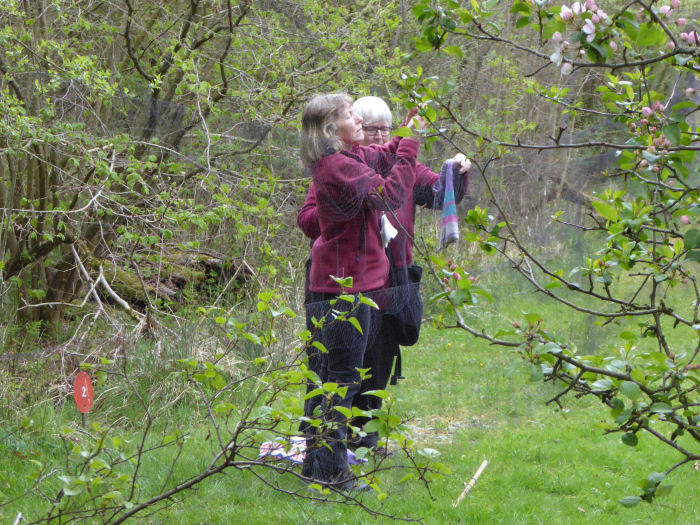
At this time of year it is mainly male birds that are caught as the females are sitting on eggs. Retrapped birds make up most of the catch as there are no young entering the population. Today there were surprises as young of Robin, Song Thrush and Blackbird were ringed.
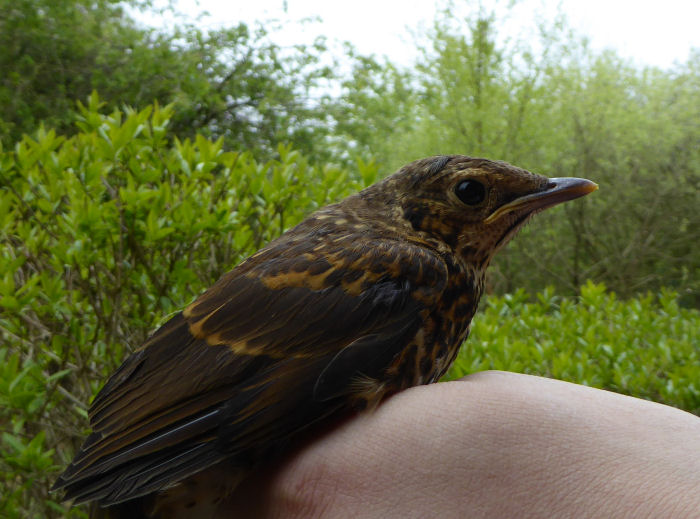
Garden Warblers and Blackcaps (below) also made an appearance.
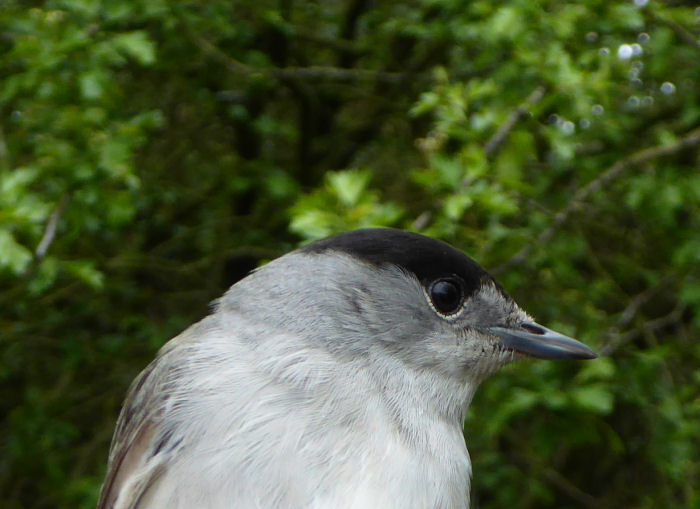
Information from IPMR showed that a Willow Warbler had made eight journeys to and from Africa, at least 40,000miles. There was a Coal Tit and Robin that were at least six years old.
Twenty two Willow Warblers were ringed and twenty three were retraps. Ten new Siskin arrived in the ringing room but not a single Redpoll after many feeding in the back garden during the week. A Brambling was passing through on its journey north and it had laid down fat reserves to help it on its way.
Results from the owl boxes have been very promising with broods of three to five healthy chicks and over 70 young and adults ringed so far. There is a good small mammal population this spring. More small holes than usual can be found at Foxglove so we have our fair share of little creatures.
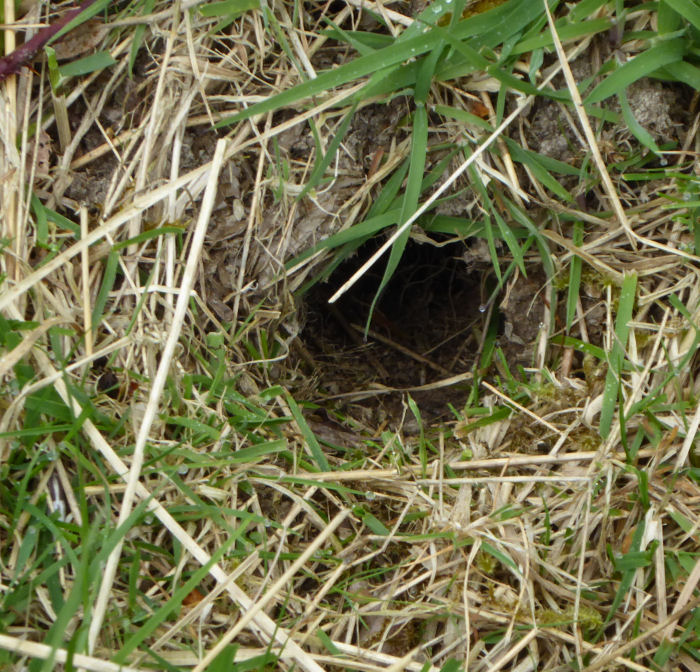
And talking of males being the most obvious birds around, these male Mallard were all resting on the duck raft.
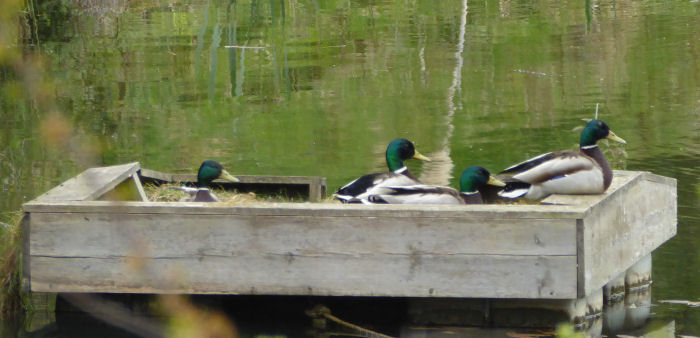
Thank you to everyone who helped today.
Pesky Vegetation!
Saturday, May 6th 2017
I am still looking through photographs to find ones that show how Foxglove has changed over 25 years. It is amazing how some areas have developed, but some things stay the same! Those pesky bits of vegetation. This was taken in 2008 and yes there is a Roe Deer hidden in the depths!

This Water Vole was swimming on the Voley Pond in 2008.

Last weekend I bemoaned the fact that the apple had a label on it! My friend took pity on me and worked his magic. No label on the apple!

And even a step further no vegetation! Thank you!

However there are times when vegetation is needed. Sightings of tadpoles have been few but when the sun shone on the wall of the weir and the floating debris, you could see that it was covered with tadpoles.

Leaves of Bulrush, Phragmites and some Elodea all provided a safe haven for the tadpoles and for some algae on which they feed.

Male Orange Tip butterflies were flitting in many sunny glades last week but would not stay still. I did not even get a splodge! I did catch this female feeding from Lady's Smock, sometimes known as Cuckoo Flower as its flowering coincides with the arrival of the Cuckoo.

So not all vegetation is pesky!
In the Woods
Thursday, May 4th 2017
A slightly smaller team joined us for Thursday volunteering today (this week appears a popular time for holidays!) - thank you to all who came to help us and we hope those who are elsewhere are having a good time. There were activities around the Field Centre and workshop, including mowing the lawn, continuing with new wood preservative on our marker posts and some servicing of our mowers and strimmers.

However, most of the activity today was taking place beyond Risedale Beck up in the conifer woodland on the green route. Here we defined the edges of one of the more unclear and meandering paths:



John did repairs to one of the boardwalks (here measuring for new edging, which we hope to get in place soon).

We also finished using slices of a wind-blown grand fir to mark another section of the route…

...we rather like it!
A Mixed Day
Wednesday, May 3rd 2017
Not all days at FGC are run of the mill. When I look back on the day it underlines how varied and diverse our day here at the reserve can be. The first job of the day was to open the moth trap put out overnight. Although we did not have a lot of moths, only 20, we did have a mixed bag of species, 13 in all. Always a pleasure to see was this Purple Thorn with its leaf little appearance.
We found this Hebrew Character in the dog drinking bowl, and as it dried out in the sun we fed it on the honey bee's sugar solution. You can clearly see the proboscis, much like a butterfly's straw-like mouth part, used for sucking up the nectar.
The butterflies were in profusion with Speckled Woods out in fairly large numbers.
We had a group in today pond dipping, where the first Large Red Damselfly was spotted on the Scrapes….
….and the Bog Bean is coming through.
At the outdoor classroom the mini beasts were a-plenty including this ground beetle larva. These are excellent hunters of smaller inverts: Look at those mandibles!
At the Nursery area Dave Peacock was harrowing, and at the same time putting seed in to eventually gain a flower crop for birds to feed on. This also brings in plenty of inverts, which also feeds our birds.
Heath and Hedges
Tuesday, May 2nd 2017
Today Foxglove was very busy. The Tuesday volunteers turned up as usual in big numbers to carry out a variety of tasks. We started with filling the feeders and continuing work replacing the cable running from the lake hide to the field centre that powers the webcam. The main task of the day was completing the dead hedge.
We have been working on this for a few Tuesdays now and today we got it finished. It looks much smarter.
Whilst in the area we also tackled some of the gorse on the edge of the heath. At this time of year it looks very pretty and seems a shame to cut it down, but we have an endless battle with gorse as it has a habit of trying to take over large swathes of the reserve. This prevents many other species from growing so any bits we can remove before the seeds ripen is a bonus.
The Dales School are back from their Easter Holidays and also came to help out. They also spent time cutting back gorse and small branches from one of the net rides.
Whilst on the heath we found this little toad.
We also found these lovely fungi, called Common Eyelash. They are tiny, about 4mm across, so very easy to miss. On close inspection you can see the tiny “eyelashes” around the edge of each cup.
After lunch Hunton and Arrathorne Primary School came to visit. They had been studying the topic of bees and enjoyed the chance to see our display honey bee hive before having a walk around the reserve.
We achieved a lot today. Thanks very much to everyone for their help today.
Lots of Stories to Tell
Monday, May 1st 2017
Jack, who rings on Salisbury Plain, is an expert at finding nests. This nest of Song Thrush chicks was right at the end of a branch of Yew. Only a mother could love these chicks, although they will turn more fluffy, a very scientific term, as their feathers develop.

He also found a Linnet's nest

and a Blackcap's nest. Once hatched and the chicks are of the correct size he will return to ring them. Blackcap has not been recorded on our observation board at Foxglove, although I did spot one on the outskirts of Darlington.

At this time of year everything is new and growing. Much of the coppiced willow is producing shoots. Food chains begin with plants and many, many animals eat them, from Roe Deer down to the tiniest weevil. This one's proboscis is firmly fixed into the small new shoot.

In early April Bee Flys made their presence known. In the sunshine they were spotted again, this time feeding on the cherry blossom. It was fascinating to watch how their bodies remained still whilst their wings were almost like humming-bird wings! They have very long legs!

Northern Marsh, Common Spotted and their hybrids and Early Marsh Orchids have been spreading their range over the last five year. The map we have that informs people where they can and cannot strim has had more marks added. One area of Early Purple Orchids (EPOs), the first to flower, was increasing in size but in the same place. There were about 10 to 12 EPOs on the wetland bank and this number had remained constant for several years. Not this year! There are more flowers over a greater area. Fantastic!

An exercise carried out regularly is feeding the Water Voles with apples. Other food given to them was rejected! I did this job yesterday and during the day watched the apples reduce in size and the number of droppings increase. One apple disappeared completely but not a Water Vole in sight. I repeated the task this morning and still no Water Voles. Taking a quick walk through the Scrapes, sort of ambling quielty, I thought I saw something on the middle raft, no could not be a Water Vole, but it was! Crept up even more quietly, if that was possible, and started taking photos. Remember to remove the label off the apple! Would also be helpful if the vegetation would move out of the way! I watched for several minutes and the amount of apple consumed was considerable.

Then a little relax before starting again.

Time to head for home as it slid off the platform. Please note the piece of vegetation!

Usually the path taken is under the pond dipping platform heading towards the boardwalk. Not this time. It swam towards me and I am sure that it knew I was there, even though I was as still as still could be.

It headed under the boardwalk and disappeared.
You can see that it uses this pathway often, as there is a channel through the leaves.

Many visitors enjoyed Foxglove over the weekend. Some had seen the television programme and were amazed that such a reserve existed in the camp and that it was so beautiful and peaceful. A Jay was feeding in the back garden and this thrilled a visitor who had never seen one before.

.JPG)
.JPG)
.JPG)
.JPG)
.JPG)
.JPG)
.JPG)
.JPG)
.JPG)
.JPG)
.JPG)


.JPG)
.JPG)
.JPG)
.JPG)
.JPG)
.JPG)

.JPG)











.JPG)
.JPG)



.JPG)





.JPG)
















.JPG)
.JPG)

.JPG)
.JPG)
.JPG)







.JPG)
.JPG)
.JPG)



.JPG)

.JPG)




.JPG)









